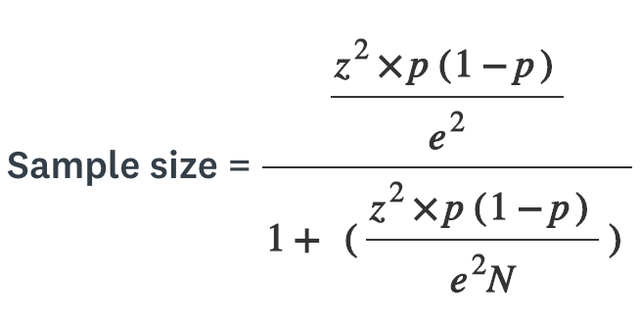
Mastering Sample Size in E-commerce Surveys: A Detailed Guide
Sample Size Calculator
Introduction
When it comes to conducting surveys, whether for market research, customer feedback, or product testing in the e-commerce sector, understanding and determining the right sample size is crucial. The accuracy of your survey results hinges on this critical factor. This guide will walk you through the essentials of sample size in statistics, with a special focus on its applications in the dynamic world of e-commerce.
Survey Basics and Sample Size Fundamentals
At its core, a survey is a research method used to gather data and insights from a predefined group of respondents. This data can range from demographic information about your target audience, or just a small segment of them, all the way to attribution data like how your customers heard about your brand?
The sample size – the number of individuals participating in your survey – is a pivotal element that can make or break the reliability of your findings. In e-commerce, where consumer preferences and trends shift rapidly, getting this number right is non-negotiable.
Luckily for us, the ideal sample size is not difficult to calculate, being an output of your total population size, the amount of error you’re willing to accept (your margin of error), and your selected confidence level (how sure you can be that your survey results reflect your population’s views).
Determine your population size by identifying if it’s your entire population you want to survey, or just a segment (all buyers of a particular SKU, for example).
Confidence Level: This metric indicates how sure you can be that the survey results reflect the views of your entire population. A standard confidence level in e-commerce surveys is 95%.
Margin of Error: This percentage represents the range within which the true value lies in relation to your survey results. A smaller margin of error means more precise results, which is vital in understanding e-commerce trends and customer preferences.
An easy way to understand Margin of Error: if 59% of your customers vote “Yes” to if you should have larger bundle discounts, with a 5% MOE, it means that between 54%-64% of the general population thinks that the answer is “Yes”
How to calculate your survey’s sample size:
If the simple-to-use tool above doesn’t float your boat, you can also do the sample size calculation by hand by following this formula:

Where:
- N = population size
- e = Margin of error (as a percentage in decimal form)
- z = z-score
The z-score is derived from the confidence level you desire. This table below provides a helpful guide for z-scores based on your desired confidence level.
| Desired confidence level | z-score |
|---|---|
| 80% | 1.28 |
| 85% | 1.44 |
| 90% | 1.65 |
| 95% | 1.96 |
| 99% | 2.58 |
E-commerce Applications of Sample Size
In the fast-paced e-commerce industry, understanding customer satisfaction and market trends is imperative. Whether you're evaluating the effectiveness of a new marketing campaign or gauging customer response to a product launch, a well-calculated sample size can provide you with reliable data to make informed decisions.
Here are some specific examples of surveys/questions you can ask with Fairing that might necessitate understanding and aiming for a certain sample size.
1. Attribution
You’ll want to get attribution data for every single customer if possible.
Where that’s not possible (there’s always going to be a certain drop off/completion rate when it comes to surveys), then you should aim for a sample size and calibrate the position and contents of your Question Stream to hit your desired Sample size (based on response rate x your monthly order volume).
2. Product research
Post-purchase surveys are a great place to survey customers about upcoming products, or get ideas on what your brand should be releasing. When you’re looking for more qualitative feedback, the importance of getting the right sample size decreases. But where you are asking customers to choose between two options, you should still aim for the right sample size based on your estimated population (# of monthly orders).
Conclusion
Understanding and accurately calculating sample size is a fundamental skill for anyone conducting surveys within the e-commerce sector. It's not just about gathering data; it's about ensuring that the data you collect is representative, reliable, and actionable. By mastering these concepts, you can confidently harness the power of statistics to drive your e-commerce strategies forward.
Ready to know your customers better?
Book a demo








